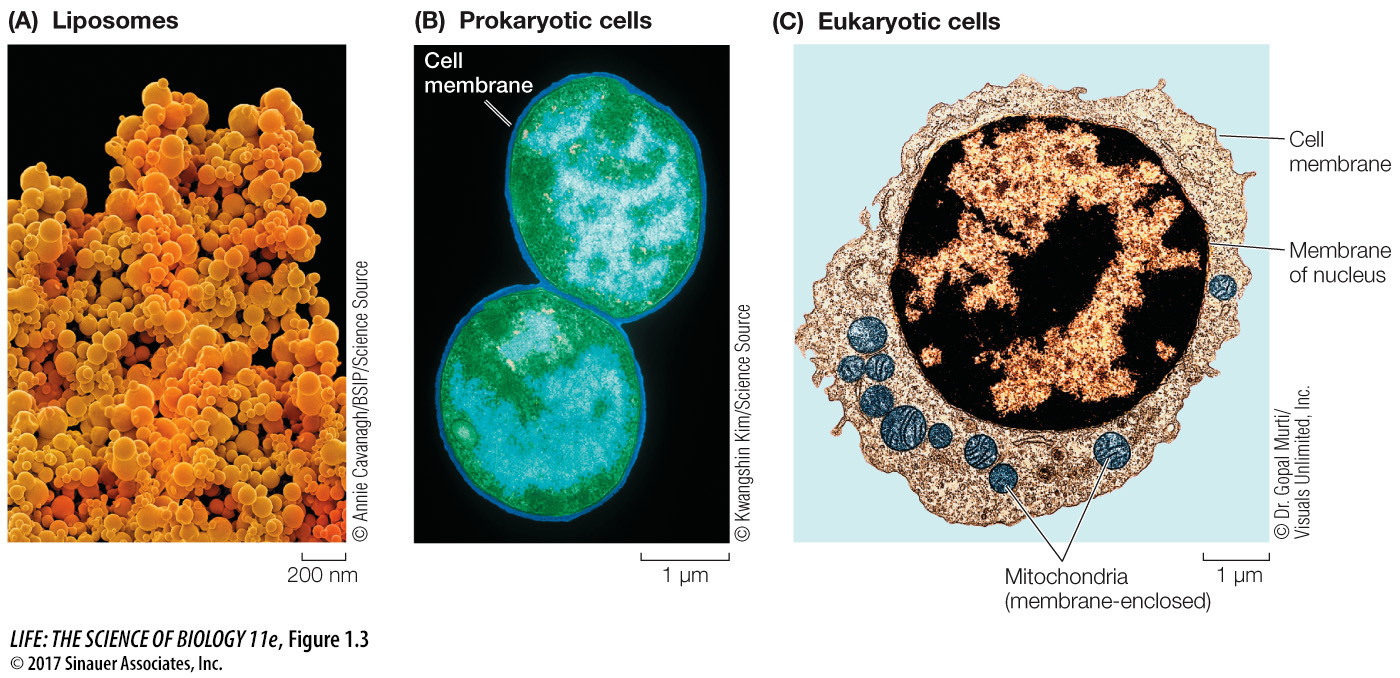Cellular structure evolved in the common ancestor of life
An important step in the evolution of life was the enclosure of complex proteins and other biological molecules by membranes that contained them in a compact internal environment separate from the surrounding (external) environment. Fatty acid molecules played a critical role in membrane evolution because these molecules do not dissolve in water. Think of shaking an oil and vinegar salad dressing. The oil breaks up into small droplets, but the droplets do not dissolve in the vinegar and they rapidly coalesce. Similarly, fatty acids can form membranous films on the surface of water. When these films are agitated, they can form spherical structures called liposomes. Such structures are now used for delivering drugs to cells (Figure 1.3A). In a primordial ocean, such membranous structures could have enveloped assemblages of complex biological molecules. The origin of an internal environment that concentrated reactants and products of chemical reactions led to the first cells with the ability to replicate themselves—the evolution of the first cellular organisms.

Figure 1.3 Cells Are Building Blocks for Life These photographs were taken with electron microscopes (see Figure 5.3) and enhanced with added color to highlight details. (A) Liposomes are tiny round bubbles known as vesicles and are made out of the same material as a cell membrane. Liposomes can be filled with drugs and used to deliver drugs to cells. (B) Two prokaryotic cells of an Enterococcus bacterium that lives in the human digestive system. Prokaryotes are unicellular organisms with genetic and biochemical material enclosed inside a single membrane. (C) A human white blood cell (lymphocyte) represents one of the many specialized cell types that make up a multicellular eukaryote. Multiple membranes within the cell-enclosing outer membrane segregate the different biochemical processes of eukaryotic cells.
Page 4
For billions of years all the organisms existing on Earth were unicellular and were enclosed by a single outer membrane. Such organisms, like the bacteria that are abundant on you, in you, and all around you, are called prokaryotes (Figure 1.3B). Two main groups diverged early in life’s history: the Bacteria and Archaea. The third major category of life on earth, the Eukarya, arose billions of years later from one group of archaea. In addition to its outer membrane, a eukaryotic cell (Figure 1.3C) has internal membranes that enclose specialized internal compartments called organelles. The organelle that gives eukaryotes their name is the nucleus—the organelle that contains the cell’s genetic information. The word “eukaryote” comes from two Greek words meaning “a true kernel.” Other organelles carry out specific functions such as synthesizing biological molecules or providing energy.
How might eukaryotes have arisen from prokaryotes? Infoldings of the prokaryote cell membrane could have formed internal compartments—the organelles—that isolated cell functions from each other, resulting in greater integration or efficiency of cell functions. Another possibility, similar to that seen in the relationship between corals and dinoflagellates described at the beginning of this chapter, is that close, interdependent relationships may have developed between different prokaryote cells, leading to a merger of sorts. Suppose a prokaryote good at converting energy was engulfed (but not digested) by a prokaryote good at synthesizing biological molecules. Each would supply a valuable service for the other, but now one would be an organelle inside the other. The structure of prokaryote and eukaryote cells, their membranes, and their evolution are the subjects of Part Two.
Single-celled organisms were the only forms of life for over half of the history of life on Earth (see Figure 1.2). However, at some point the cells of some eukaryotes didn’t separate after cell division, instead they remained attached to each other. Such colonial aggregations of cells made it possible for some of the associated cells to specialize in certain functions, such as reproduction, while other cells specialized in other functions, such as absorbing nutrients or motility. This cellular specialization enabled multicellular eukaryotes to increase in size and become more efficient at gathering resources and adapting to specific environments.
